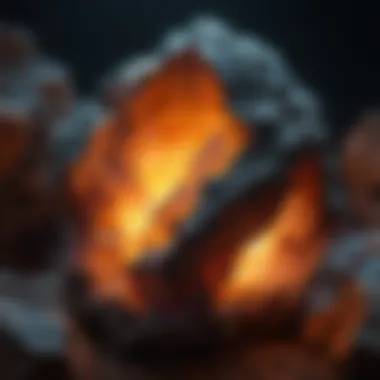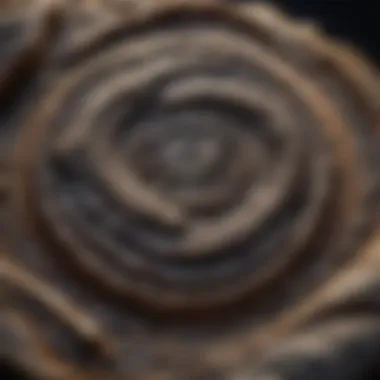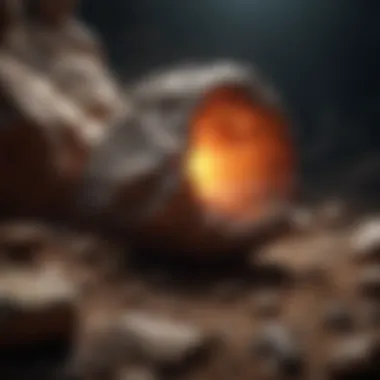Unveiling the Profound Advantages of UV Light Flashlights for Rock and Fossil Enthusiasts


Rock and Fossil Identification
Are you a keen rock and fossil enthusiast always on the lookout for new ways to enhance your collecting experience? An impactful tool gaining popularity among collectors is the UV light flashlight. These handy devices offer a unique perspective on geological specimens, unveiling hidden details that may go unnoticed under regular light. Understanding the science behind UV light is key to fully appreciating its benefits in rock and fossil identification.
When it comes to rock and fossil identification, various types of specimens can be encountered, each with distinct characteristics that make them stand out. UV light flashlights play a crucial role in this process by highlighting specific features that are not easily visible to the naked eye. Whether it's fluorescent minerals or fossils, using UV light can aid collectors in accurately identifying and cataloging their finds.
Additionally, knowing what characteristics to look for in rocks and fossils is essential for collectors aiming to build a comprehensive collection. UV light is instrumental in discerning unique patterns, colors, and textures that can provide clues about the specimen's composition and origin. By incorporating UV light flashlights into your identification toolkit, you open up a world of details that adds depth to your collecting endeavors.
Exploring further, understanding the tools required for identification is pivotal. While traditional methods rely on visual inspection and basic testing, incorporating UV light technology elevates the process to a new level. By utilizing UV light flashlights alongside specialized instruments, collectors can conduct thorough examinations and determine the composition and mineralogy of their specimens with enhanced precision.
Introduction
In delving into the realm of UV light flashlights, a profound journey awaits rock and fossil collectors. The utilization of UV light in this context unveils a plethora of hidden potentials and transformative benefits. This article serves as a guide shedding light on the significance of UV light flashlights, offering a deep dive into their applications, both in understanding the science behind UV light and practical implications in rock and fossil collection.
Understanding UV Light
The Science Behind UV Light
The intricacies of the electromagnetic spectrum bring the science behind UV light into focus. UV light falls between visible light and X-rays, encompassing wavelengths approximately 10 to 400 nanometers. This specific wavelength range plays a crucial role in revealing hidden properties of minerals and fossils. Its ability to cause fluorescence in certain materials is a key characteristic that aids in identifying unique features not visible under normal light conditions.
Types of UV Light
Within the UV spectrum, various types of UV light exist, categorized based on their wavelength bands. The most common divisions include UV-A, UV-B, and UV-C. UV-A, with longer wavelengths, is often used in fluorescence and mineral identification due to its ability to illuminate certain compounds effectively. UV-B and UV-C, although possessing higher energy levels, find limited usage in the context of rock and fossil collecting due to their potential harm to specimens when not handled with care.
UV Light Flashlights in Collecting
Benefits of UV Light in Geology
The incorporation of UV light in geology revolutionizes the identification and examination of minerals. UV light fluorescence helps distinguish minerals that may otherwise look similar under daylight, thus enhancing accuracy in mineral classification. This innovative approach brings to light subtle differences in mineral composition, providing collectors with deep insights into the geologic history of their specimens.
Practical Uses for Rock and Fossil Collectors


For rock and fossil collectors, UV light flashlights serve a dual purpose of practicality and fascination. By using UV light, collectors can identify specific minerals with ease, distinguishing between fluorescent and non-fluorescent specimens. Moreover, the ability of UV light to reveal unique patterns and textures that are indiscernible under ordinary light intensifies the appeal of using these tools in examining and showcasing rock and fossil collections.
Enhancing Collection Experience
In the realm of rock and fossil collecting, the aspect of enhancing the collection experience reigns supreme. Rock and fossil collectors are constantly seeking ways to enrich their understanding and appreciation of geological specimens through innovative tools and techniques. The utilization of UV light flashlights in this endeavor proves to be a game-changer, opening up a whole new world of hidden details and fluorescence patterns that are invisible to the naked eye. By delving into the fluorescence of minerals under UV light, collectors can uncover unique characteristics and qualities that elevate their collections to new heights. Moreover, the ability to spot fluorescence not only enhances the aesthetic appeal of specimens but also provides valuable insights into their composition and geological significance, making the collecting experience more comprehensive and rewarding.
Spotting Fluorescence
Identifying Minerals
Identifying minerals through fluorescence plays a pivotal role in rock and fossil collecting, offering collectors a distinctive way to distinguish different minerals based on their fluorescent properties. Under the illumination of UV light, certain minerals exhibit vibrant and distinct colors, allowing collectors to identify them with precision. This process of identification using fluorescence not only aids in cataloging specimens but also enhances the categorization and classification of rocks and fossils in a collection. The unique feature of identifying minerals through fluorescence lies in its non-destructive nature, enabling collectors to differentiate minerals without altering or damaging the specimens. This method proves to be highly beneficial for collectors looking to expand their knowledge and understanding of minerals in a safe and efficient manner.
Revealing Unique Patterns
Revealing unique patterns through fluorescence adds a layer of complexity and intrigue to the world of rock and fossil collecting. In addition to identifying individual minerals, UV light flashlights can unveil intricate patterns and textures present in rocks and fossils that are invisible under normal light. These patterns, often caused by the presence of certain minerals or impurities, contribute to the overall aesthetic appeal and scientific value of specimens. By revealing these unique patterns, collectors gain insight into the geological history and formation processes behind each rock or fossil, enriching their collecting experience with a deeper understanding of the earth's geological heritage. The use of UV light to reveal such patterns not only enhances the visual appeal of specimens but also provides collectors with valuable information for further research and study.
Preservation Techniques
Preventing Damage
In the realm of rock and fossil collecting, the preservation of specimens is paramount to maintaining their integrity and scientific value. UV light flashlights play a crucial role in preventing damage to specimens by offering a non-invasive method of examination. Unlike traditional lighting sources that can cause discoloration or deterioration over time, UV light illuminates specimens without posing any risk of harm. This preservation technique ensures that rocks and fossils retain their original appearance and properties, allowing collectors to showcase them without fear of degradation. The key characteristic of preventing damage using UV light lies in its ability to provide adequate lighting for examination and photography without compromising the quality or longevity of specimens, making it a preferred choice for collectors seeking to preserve their collections for posterity.
Displaying Specimens
Displaying specimens effectively is essential for rock and fossil collectors to share their discoveries and insights with others. UV light flashlights aid collectors in showcasing specimens in the best possible light, quite literally. By using UV light to display specimens, collectors can highlight fluorescence patterns and unique features that are not visible under normal lighting conditions, creating a mesmerizing visual display. This technique not only attracts attention but also educates viewers on the diverse properties and compositions of rocks and fossils, fostering a greater appreciation for the earth's geological wonders. The unique feature of displaying specimens under UV light lies in its ability to transform ordinary rocks and fossils into vibrant, glowing exhibits that captivate and inspire viewers. By incorporating UV light into the display process, collectors can create engaging and immersive experiences that elevate their collections to new heights.
Applications in Geology
When delving into the realm of rock and fossil collecting, understanding the applications of UV light flashlights in geology proves indispensable. These tools play a pivotal role in shedding light on the hidden characteristics of minerals and fossils. By utilizing UV light, collectors can uncover intricate details that are invisible to the naked eye. This capability aids in identifying different mineral compositions and patterns within rocks and fossils, enhancing the overall collecting experience.
Geological Significance
Illuminating Mineral Composition


Exploring the facet of illuminating mineral composition through UV light exposure offers a profound insight into the mineral makeup of geological specimens. By illuminating minerals under UV light, collectors can discern the unique fluorescence patterns exhibited by various minerals. This distinctive feature allows collectors to differentiate between different mineral types based on their fluorescence behavior, providing valuable information for geological analysis. The ability to visualize mineral composition under UV light is a key advantage for rock and fossil collectors, enabling a more in-depth understanding of the specimens' geological characteristics.
Identifying Unique Features
Another crucial aspect of UV light applications in geology is the ability to identify unique features within rocks and fossils. With UV light exposure, certain minerals exhibit distinct fluorescence patterns that can help collectors identify specific minerals and geological formations. This characteristic feature aids in showcasing the distinctiveness of specimens, highlighting intricate details that are otherwise not readily visible. Through this process, collectors can showcase the unique features of their collections, adding a new dimension to their geological discoveries.
Field Excursions
Detecting Minerals in Nature
For enthusiasts embarking on field excursions to discover minerals in their natural habitat, UV light flashlights serve as invaluable tools. The ability to detect minerals in nature through UV light fluorescence aids collectors in identifying different types of minerals present in geological formations. By using UV light, collectors can spot fluorescence reactions in rocks and soil, indicating the presence of specific minerals. This method enhances the effectiveness of mineral detection during field excursions, allowing collectors to broaden their geological knowledge and specimen collection.
Exploring Geological Formations
When exploring diverse geological formations, the use of UV light flashlights unveils a new dimension of discovery. By illuminating rocks and terrain with UV light, collectors can observe the intricate fluorescent patterns embedded within geological formations. This process aids in highlighting the geological history and composition of rocks, offering insights into the environmental conditions that shaped these formations. Exploring geological formations with UV light enhances the educational value of field excursions, providing a deeper understanding of the geological processes that have influenced the landscape.
Choosing the Right UV Light
When delving into the realm of rock and fossil collection, selecting the appropriate UV light flashlight is of utmost importance. The right UV light can unveil hidden fluorescent properties in minerals and fossils that are otherwise invisible to the naked eye. Factors to consider when choosing a UV light include its wavelength options, portability, and durability, all of which play a pivotal role in enhancing the collecting experience.
Factors to Consider
Wavelength Options
Wavelength options are crucial when selecting a UV light for rock and fossil collectors. The wavelength determines the type of fluorescence that will be observed in specimens. Shortwave UV lights, around 254 nm, are ideal for geological applications as they reveal different fluorescent colors compared to longwave UV lights. Rock and fossil enthusiasts can benefit from having a UV light with multiple wavelength options to explore the varied fluorescence exhibited by different minerals and fossils.
Shortwave UV lights offer the advantage of showcasing specific fluorescent characteristics that aid in mineral identification, while longwave UV lights provide a broader range of fluorescence. Balancing between these options can lead to a more comprehensive examination of geological samples, enriching the collector's experience.
Portability and Durability
Considering the portability and durability of a UV light is essential for collectors who often find themselves in remote or rugged terrain. A portable UV light allows for easier transportation during field expeditions, enabling collectors to examine specimens on-site efficiently. Moreover, a durable UV light ensures longevity and reliability in challenging environmental conditions, such as rocky terrains or humid caves.


Portability enhances the flexibility of collectors, granting them the freedom to study rocks and fossils in various locations without constraints. The durability of a UV light guarantees its functionality even in rough outdoor settings, contributing to a seamless collecting process for enthusiasts.
Popular Models
Top Picks for Collectors
Top picks for rock and fossil collectors often encompass UV lights that offer a balance between functionality and performance. These models usually feature adjustable wavelength settings, ensuring versatility in observing different mineral compositions. The top picks aim to provide collectors with a comprehensive tool for identifying fluorescent patterns and unique features in rocks and fossils.
Moreover, top UV light models for collectors prioritize user-friendly designs, ergonomic grips, and long-lasting battery life, catering to the practical needs of enthusiasts during field excursions. These models are tailored to enhance the overall collecting experience by offering convenience and efficiency in specimen examination.
Budget-Friendly Options
For collectors on a budget, there exist UV light models that provide optimal functionality without compromising quality. Budget-friendly options encompass UV lights that offer essential features for mineral identification and fluorescence detection. While these models may have fewer advanced settings, they serve as a cost-effective solution for hobbyists and amateur collectors.
Budget-friendly UV lights prioritize affordability and accessibility, ensuring that enthusiasts with varying budget constraints can still benefit from utilizing UV technology in their collecting endeavors. By choosing an economical UV light, collectors can embark on their rock and fossil exploration journey without financial barriers.
Conclusion
In concluding this exploration into the benefits of UV light flashlights for rock and fossil collectors, it is evident that these tools offer a wealth of advantages in the field. With their ability to reveal hidden mineral compositions, identify unique geological features, and enhance the overall collecting experience, UV light flashlights have become indispensable for enthusiasts in the field of geology and paleontology. By shedding light on these aspects, collectors can not only appreciate the aesthetic beauty of specimens but also gain valuable scientific insights that may have been otherwise overlooked.
Summary of Benefits
Enhanced Collecting Experience
The enhanced collecting experience facilitated by UV light flashlights is a game-changer for rock and fossil collectors. By enabling enthusiasts to spot fluorescence, identify minerals, and reveal unique patterns in specimens, these tools significantly augment the ability to appreciate and study geological formations. The key characteristic of this enhanced experience lies in its ability to unveil the hidden details and intricacies of rocks and fossils, offering collectors a new perspective on their prized specimens. Despite its advantages in enhancing the visual appeal and scientific value of collections, one potential disadvantage is the increased need for careful handling to prevent damage while examining specimens under UV light.
Scientific Insights
The scientific insights provided by UV light flashlights contribute immensely to the overarching goal of understanding geological specimens. Their ability to illuminate mineral compositions, identify specific minerals, and highlight unique features aid collectors in conducting detailed analyses and interpretations of their findings. The key characteristic of scientific insights derived from UV light exposure lies in the ability to unveil the true nature of specimens, revealing details that may not be perceptible under normal lighting conditions. While this offers substantial benefits in terms of uncovering valuable data and enhancing research endeavors, a potential downside involves the necessity for additional expertise to correctly interpret the findings obtained through UV illumination.
Future Trends
Innovations in UV Technology
The ongoing innovations in UV technology present exciting prospects for rock and fossil collectors, offering advanced functionalities and improved efficiency in specimen analysis. The key characteristic of these innovations lies in their ability to provide enhanced clarity and precision in identifying minerals, which is advantageous for researchers and collectors alike. The unique feature of these technological advancements is their capacity to offer customizable wavelength options, ensuring versatility in examining different types of geological samples. While these innovations bring notable benefits in terms of efficiency and accuracy, one potential drawback is the higher cost associated with acquiring cutting-edge UV technology.
Potential Applications
The potential applications of UV light flashlights in the field of rock and fossil collecting are diverse and promising, opening new avenues for research and exploration. The key characteristic of these applications is their versatility in detecting minerals in nature, exploring geological formations, and analyzing specimens with precision. This makes them a popular choice among collectors seeking to gain deeper insights into the composition and origins of their finds. While these applications offer significant advantages in terms of research capabilities and specimen examination, a potential limitation is the reliance on external factors such as ambient lighting conditions, which may impact the effectiveness of UV illumination in certain environments.







